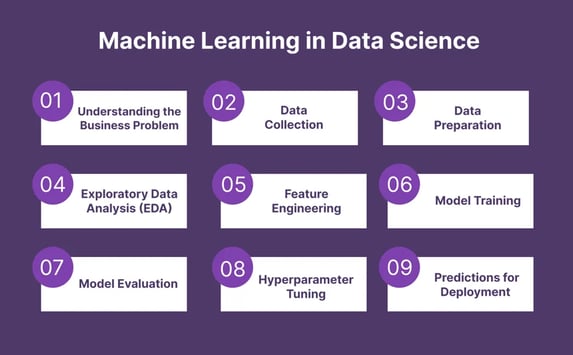The Role of Machine Learning in Data Science

Data Science is all about generating insights from raw data. This can be achieved by exploring data at a very granular level and understanding the trends. Machine learning finds hidden patterns in the data and generates insights that help organizations solve the problem.
The role of Machine learning in Data Science comes into play when we want to make accurate estimates about a given set of data, such as predicting whether a patient has cancer or not.
The role of Machine learning in Data Science comes into play when we want to make accurate estimates about a given set of data, such as predicting whether a patient has cancer or not.
The role of machine learning in Data Science occurs in 9 steps:
1. Understanding the Business Problem
To build a successful business model, it’s very important to understand the business problem that the client is facing. Suppose the client wants to predict whether the patient has cancer or not. In such scenario, domain experts understand the underlying problems that are present in the system.
2. Data Collection
After understanding the problem statement, you have to collect relevant data. As per the business problem, machine learning helps collect and analyze structured, unstructured, and semi-structured data from any database across systems.
3. Data Preparation
The first step of data preparation is data cleaning. It is an essential step for preparing the data. In data preparation, you eliminate duplicates and null values, inconsistent data types, invalid entries, missing data, and improper formatting.
4. Exploratory Data Analysis (EDA)
Exploratory Data Analysis lets you uncover valuable insights that will be useful in the next phase of the Data Science lifecycle. EDA is important because, through EDA, you can find outliers, anomalies, and trends in the dataset. These insights can be helpful in identifying the optimal number of features to be used for model building.
5. Feature Engineering
Feature engineering is one of the important steps in a Data Science Project. It helps in creating new features, transforming and scaling the features. In this domain, expertise plays a key role in generating new insights from the data exploration step.
6. Model Training
In Model training, we fit the training data; this is where “learning” starts. We train the model on training data and test the performance on testing data i.e., unseen data.
7. Model Evaluation
Once Model Training is done, it’s time to evaluate its performance. So, evaluating your Model on a new dataset will give you an idea of how your Model is going to perform in future data.
8. Hyperparameter Tuning
After the Model is trained and evaluated, the performance of the Model can be again improved by tuning its parameter. Hyperparameter tuning of the model is important to improve the overall performance of the model.
9. Making Predictions and Ready to be Deployed
This is the final stage of machine learning. Here, the machine answers each of your questions by its learning. After making accurate predictions, the Data Model is deployed into production.
Data scientists use machine learning for a variety of reasons, but here are some of the most important ones:
1. To extract insights from large datasets: Machine learning algorithms can analyze massive amounts of data much faster and more efficiently than humans can. This allows data scientists to discover hidden patterns, trends, and relationships that might otherwise go unnoticed. These insights can be used to inform business decisions, improve product development, personalize customer experiences, and much more.
2. To make predictions: Machine learning models can be trained to learn from historical data and then use that knowledge to make predictions about the future. This can be useful for tasks like forecasting sales, predicting customer churn, or identifying potential fraud.
3. To automate tasks: Machine learning can automate many repetitive and time-consuming tasks that data scientists would otherwise have to do manually. This frees up their time to focus on more strategic work, such as interpreting results and communicating insights to stakeholders.
4. To handle complex data: Machine learning can be used to analyze complex and unstructured data, such as text, images, and audio. This type of data can be difficult to analyze using traditional methods, but machine learning algorithms are able to extract valuable insights from it.
5. To improve accuracy and efficiency: Machine learning models can often achieve higher accuracy and efficiency than traditional data analysis methods. This is because they can learn and improve over time, as they are exposed to more data.
